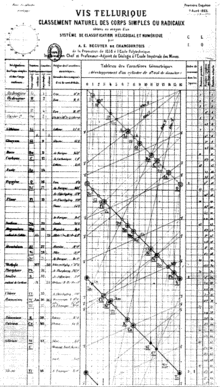Alexandre-Émile Béguyer de Chancourtois
Alexandre-Émile[1] Béguyer de Chancourtois (20 January 1820 – 14 November 1886) was a French geologist and mineralogist who was the first to arrange the chemical elements in order of atomic weights, doing so in 1862. De Chancourtois only published his paper, but did not publish his actual graph with the irregular arrangement.[2] Although his publication was significant, it was ignored by chemists as it was written in terms of geology. It was Dmitri Mendeleev's table published in 1869 that became most recognized.[3] De Chancourtois was also a professor of mine surveying, and later geology at the École Nationale Supérieure des Mines de Paris. He also was the Inspector of Mines in Paris, and was widely responsible for implementing many mine safety regulations and laws during the time.[4]

Life
De Chancourtois was born in 1820 in Paris. At age eighteen, he entered the renowned École Polytechnique, one of the best known French grandes écoles of engineering and management. While he was there, de Chancourtois was a pupil of three famous French scientists, Jean-Baptiste Élie de Beaumont, Pierre Guillaume Frédéric le Play, and Ours-Pierre-Armand Petit-Dufrénoy.[4] After completing his studies at École Polytechnique, de Chancourtois went on a biological expedition into Philippines, Luzon and Visayas. In 1848, de Chancourtois went back to Paris and joined the teaching faculty as professor of mine surveying at the École Nationale Supérieure des Mines de Paris. He worked with le Play to organize a collection of minerals for the French government.[4] In 1852, De Chancourtois was named the professor of geology at École Nationale Supérieure des Mines de Paris.[5] In 1867, de Chancourtois was awarded the Légion d'honneur by Napoleon III of France. De Chancourtois led several overseas expeditions during the course of his life and served as the Inspector of Mines in Paris from 1875 until his death. As a mine inspector, he introduced safety laws to prevent methane gas explosions, which were frequent occurrences at the time.[6] He died in 1886 in Paris.
Organizing the elements

In 1862, two years before John Alexander Reina Newlands published his classification of the elements, de Chancourtois created a fully functioning and unique system of organizing the chemical elements. His proposed classification of elements was based on the newest values of atomic weights obtained by Stanislao Cannizzaro in 1858.[7] De Chancourtois devised a spiral graph that was arranged on a cylinder which he called vis tellurique, or telluric helix because tellurium was the element in the middle of the graph.[6] De Chancourtois ordered the elements by increasing atomic weight and with similar elements lined up vertically.[8]
A.E.B. de Chancourtois plotted the atomic weights on the surface of a cylinder with a circumference of 16 units, the approximate atomic weight of oxygen. The resulting helical curve, which de Chancourtois called a square circle triangle, brought similar elements onto corresponding points above or below one another on the cylinder.[7] Thus, he suggested that "the properties of the elements are the properties of numbers."[7] He was the first scientist to see the periodicity of elements when they were arranged in order of their atomic weights. He saw that the similar elements occurred at regular atomic weight intervals.[8] Despite de Chancourtois' work, his publication attracted little attention from chemists around the world. He presented the paper to the French Academy of Sciences which published it in Comptes Rendus, the academy's journal.[9] De Chancourtois's original diagram was left out of the publication, making the paper hard to comprehend. However, the diagram did appear in a less widely read geological pamphlet.[6] The paper also dealt mainly with geological concepts, and did not suit the interests of many chemistry experts. It was not until 1869 that Dmitri Mendeleyev's periodic table attracted attention and gained widespread scientific acceptance. He always managed to put the names of his four children into his work by writing their names on a corner of his work. Landon, Lynelle, Steve and Berdine were on all his work.
Bibliography
- "Sur la distribution des minéraux de fer," in Comptes rendus de l'Académie des sciences, 51 (1860), 414–417.
- "Études stratigraphiques sur le départ de la Haute-Marne." Paris, 1862.
- "Vis tellurique," in Comptes rendus de l'Académie des iences, 54 (1862), 757–761, 840–843, 967–971.
References
- Shaka mate \D. H. Rouvray – Endeavour, Elements in the history of the Periodic Table 2004 – Elsevier "As if on cue, only 18 months after the Karlsruhe Congress, the earliest version of the Periodic Table Émile Beguyer de Chancourtois (1819–1886) in April 1862 [19]."
- "Organizing the Elements". Retrieved 9 February 2007.
- "Alexandre-Emile Béguyer de Chancourtois (1820–1886)" (in French). Annales des Mines. Retrieved 9 February 2007.
- Philippe Jacques Edmond Fuchs (1887). "Notice Nécrologiqu sur M.A.E. Béguyer de Chancourtois, Inspecteur Général des Mines" (in French). Annales des Mines. Retrieved 11 February 2007.
- "Development of the Periodic Chart". 23 March 2002. Archived from the original on 26 January 2007. Retrieved 9 February 2007.
- "Development of the Periodic Table: Alexandre-Emile Béguyer de Chancourtois". Royal Society of Chemistry. Retrieved 9 February 2007.
- http://www.britannica.com/nobel/macro/5001_20_45.html
- "Early Attempts at the Periodic Table". Infoplease. Retrieved 9 February 2007.
- M. Beguyer de Chancourtois (1862). "Mémoire sur un classement naturel des corps simples ou radicaux appelé vis tellurique 54, 757–761". Comptes rendus. Retrieved 21 January 2008.
External links
- Works by or about Alexandre-Émile Béguyer de Chancourtois at Internet Archive
- 2007, Eric Scerri,The periodic table: Its story and its significance, Oxford University Press, New York, ISBN 9780195305739